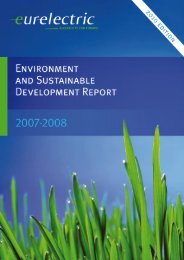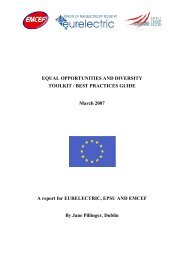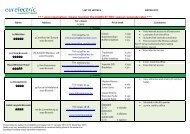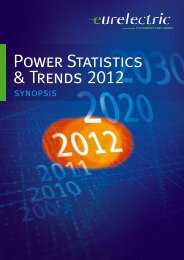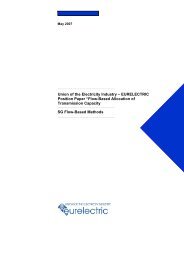Power Statistics - 2010 Edition - Full Report - Eurelectric
Power Statistics - 2010 Edition - Full Report - Eurelectric
Power Statistics - 2010 Edition - Full Report - Eurelectric
Create successful ePaper yourself
Turn your PDF publications into a flip-book with our unique Google optimized e-Paper software.
Balances 4.4 Comments<br />
LATVIA (lv)<br />
Latvia is a power deficit country. The necessary amount of electricity was imported from Russia,<br />
Lithuania and Estonia.<br />
Latvenergo HPPs (run-of-river type) are located on the River Daugava. They are used to cover peak<br />
loads as well as for the spinning reserve for the Baltic region. The generation depends on water inflow.<br />
During spring flood period (i.e. about two months) Latvian HPPs can supply the whole national demand.<br />
Due to the irregular water supply, there are big fluctuations in the generation of the electric energy.<br />
In 1998 HPPs generated 4.3 TWh, but in 1996 only – 1.8 TWh. HPPs energy production was 3.1 TWh<br />
in 2008.<br />
POLAND (pl)<br />
The directions of Polish energy exchanges are the same as in the past years and its structure untill the<br />
year 2020 is shown in Fig.2.<br />
germany<br />
ucte<br />
Fig.2 Directions of current and future Polish electricity exchange.<br />
Based on information presented in the UCTE <strong>Report</strong> all import comes from the Polish- Swedish and<br />
Polish-Ukraine border.<br />
Connection between Poland and Sweden is set on DC cable. Connections with Lithuania and Ukraine<br />
are planned as back-to-back stations.<br />
Imports from UCTE countries should be executed through existing and planned interconnections with<br />
neighbouring countries.<br />
In 2008, the electric energy exchange balance was essentially reduced due to priority for covering<br />
national demand.<br />
PORTUGAL (pt)<br />
czech republic<br />
sweden<br />
poland<br />
slovakia<br />
lithuania<br />
ukraine<br />
The foreseeable not available capacity corresponds to a percentage of the installed capacity of the<br />
special regime generation (excluding hydro) defined according to the technology.<br />
The required reserve capacity considers:<br />
The forced outage of the thermal and hydro units with higher capacity of the public electricity system<br />
in the peak period;<br />
The temperature effect on the annual peak load (a maximum increase of 6.9% on the expected<br />
peak was assumed);<br />
The capacity limitation of the hydro subsystem for dry conditions, in the period of the year where<br />
peak demand is expected to occur.<br />
<strong>Power</strong> <strong>Statistics</strong> – <strong>2010</strong> <strong>Edition</strong> – <strong>Full</strong> <strong>Report</strong> 173



